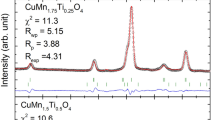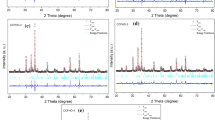Abstract
A strong anomaly was found in the heat capacity of Co3O4 between 1000 K and the decomposition temperature. This anomaly is not related to the decomposition of Co3O4 to CoO. The measured entropy of transition, ΔS=46±4 J mol-1 K-1 of Co3O4, supports the interpretation that this anomaly reflects a spin unpairing transition in octahedrally coordinated Co3+ cations. Experimental values of heat capacity, heat content and entropy of Co3O4 in the high temperature region are provided. The enthalpy of the spin unpairing transition is 53±4 kJ mol-1 of Co3O4.
Similar content being viewed by others
References
Chenavas J, Joubert JC, Marezio M (1971) Low spin — High spin state transition in high pressure cobalt sequioxide. Sol State Commun 9:1057–1060
Chibrova FKh, Belova ID, Zakharin DS, Reiman SI, Roginskaya YuE, Venevtsev (1984) High-spin Co(III) in Co3−xO4 films with defects. Fiz Tverd Tela 26:890–893
Cossee P (1958) Magnetic properties of cobalt in oxide lattices. J Inorg Nucl Chem 8:483–488
Flamand R (1984) Decomposition thermique de l'oxyde de cobalt Co3O4. High Temperature — High Pressure 16:323–328
Gaune-Escard M, Bros JP (1974) High temperature calorimetry up to 1800 K. Can Met Quat 13:335–338
Hill RJ (1982) in O'Neill H.St.C (1985) Thermodynamics of Co3O4: a possible electron spin unpairing transition in Co3+. Phys Chem Minerals 12:149–154
Johnson KH (1973) Scattered wave theory of the chemical bond. Adv Quant Chem 7:143–185
Kale GM, Pandit SS, Jacob KT (1988) Thermodynamics of cobalt (II,III) oxide (Co3O4): evidence of phase transition. Transact J Inst Met 29:125–132
Khriplovich LM, Kholopov GV, Paukov IE (1982) Heat capacity and thermodynamic properties of Co3O4 from 5 to 307 K.Low temperature transition. J Chem Thermodyn 14:207–217
King EG, Christiansen Au Jr. (1958) Heat content above 298.15 K of oxides of cobalt and nickel. J Am Chem Soc 80:1800–1801
Knopp O, Reid KIG, Sutarano, Nakagawa Y (1968) Chalkogenides of the transition elements.VI. X-ray, neutron and magnetic investigation of the spinels Co3O4, NiCo2O4, CoS4 and NiCo2S4. Can J Chem 46:3463–3476
Kaumoto K, Yanagida H (1981) Electrical conduction in pure and Li-substituted Co3O4. J Am Ceram Soc 64:C156–157
Lange RA, DeYoreo JJ, Navrotsky A (1991) Scanning calorimetric measurement of heat capacity during incongruent melting of diopside. Am Mineral 76:904–912
Liu X, Prewitt ChT (1990) High-temperature x-ray diffraction study of Co3O4: transition from normal to disorder spinel. Phys Chem Minerals 17:168–172
Madhusudan WH, Jagannathan K, Ganguly P, Rao CNR (1980) A magnetic susceptibility study of spin-state transitions in rare-earth trioxocobaltites (III). J Chem Soc Dalton Trans:1397–1400
Navrotsky A, Davies PK (1981) Cesium chloride versus nickel arsenide as possible structures for (Mg,Fe)O in the lower mantle. J Geophys Res 86:3689–3694
O'Bryan HM Jr, Parravano G (1965) The univariant equilibrium between the oxides of cobalt. Proceedings of the 5th International Conference on Reactivity of Solids, p 256
O'Neill H.St.C (1985) Thermodynamics of Co3O4: a possible electron spin unpairing transition in Co3+. Phys Chem Minerals 12:149–154
Raccah PM, Goodenough JB (1967) First — order localized — electron collective electron transition in LaCoO3. Phys Rev 155:932–943
Robie RA, Hemingway BS, Fisher JR (1978) Thermodynamic properties of minerals and related substances at 298.15 K and 1 bar (105 pascals) pressure and at higher temperatures. US Geological Survey Bulletin 1452
Roth WL (1964) The magnetic structure of Co3O4. J Phys Chem Solids 25:1–10
Scheerlinck D, Hautecler S (1976) Magnetic interactions in Co3O4. Phys Stat Sol (b) 73:223–228
Seitz F (1987) The modern theory of solids. Dover Publications, New York
Shannon RD (1976) Revised effective ionic radii and systematic studies of interatomic distances in halides and chalcogenides. Acta Crystallogr A32:751–767
Sherman DM (1985) The electronic structures of Fe3+ coordination sites in iron oxides; applications to spectra, bonding and magnetism. Phys Chem Minerals 12:161–175
Sherman DM (1988) High-spin to low-spin transition of iron(II) oxides at high pressures: possible effects on the physics and chemistry of the lower mantle. In: Structural and magnetic phase transitions in minerals. Springer, Berlin Heidelberg NewYork
Sherman DM (1991) The high-pressure electronic structure of magnesiowustite, (Mg,Fe)O: Applications to the physics and chemistry of the lower mantle. J Geophys Res 9:14299–14312
Tossell JA, Vaughan DJ, Johnson KH (1974) Electronic structure of rutile, wustite and hematite from molecular orbital calculations. Am Mineral 59:319–334
Touzelin B (1978) Etude par diffraction des rayons X a haute temperature, en atmosphere controlee, des oxydes de cobalt et de nickel. Rev Int Hautes Temp Refract 15:33–41
Ziegler D, Navrotsky A (1986) Direct measurement of the enthalpy of fusion of diopside. Geochim Cosmochim Acta 50:2461–2466
Author information
Authors and Affiliations
Rights and permissions
About this article
Cite this article
Mocala, K., Navrotsky, A. & Sherman, D.M. High-temperature heat capacity of Co3O4 spinel: thermally induced spin unpairing transition. Phys Chem Minerals 19, 88–95 (1992). https://doi.org/10.1007/BF00198606
Received:
Accepted:
Issue Date:
DOI: https://doi.org/10.1007/BF00198606




